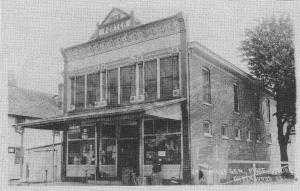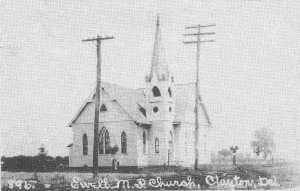Collecting Delaware Books
Delaware Postcards
by Glenn A. Rude and John P. Reid
Book collectors find that postcard collecting is another world. Serious postcard collectors have a language and customs all their own. But Delaware postcards can be a fascinating addition to a Delaware book fans collection.
Postcard History
Postcards, including picture postcards, existed in Europe from 1870. In the U.S., cards required full first class postage of two cents. However in 1898, a one-cent postcard was authorized. For the first few years these were marked "Private Mailing Card Authorized by Act of Congress on May 19, 1898." Nothing but the address could be placed on the address and stamp side, so if the other side bore a picture, there was no place for text.
A "divided back" card, similar to todays, where address and text are side-by-side, was authorized in 1907.
The earliest postcards were either simple printed designs or "real photo" cards. Real photos were printed individually from a negative in the darkroom on photographic paper. Kodak and many other companies produced postcard-size cameras and film as well as photographic printing paper with the address side of the card preprinted on the back.
Real photos were once despised by collectors, because they were often crude and unsophisticated. Today they are the premier cards for collectors interested in local views. Real photos are a window into yesterdays world. They always bring a premium price.
Real photos were sometimes hand colored. Such cards are rare.
Within a decade or two it became common to produce cards by printing press instead. Sometimes they carried the same view as an earlier real photo. Such printed cards, called "black-and-white" cards, can be distinguished by the photo-engraving dot pattern visible with a moderate power magnifying glass.
Printed color postcards first appeared around 1916. These were sometimes of inferior quality. Collectors call them "white border cards." In 1930, a new process permitted printing color cards on stock with a woven texture. These are called "linens" and were produced until 1945.
The superior "photochrome" process was developed in 1939 and is in use to the present day. Such cards are called "chromes."
Postcard Collecting
Postcard collecting is a vast field. There are people who collect only advertising, art nouveau, aviation, bears, carnival or circus, cats, children, Disney, dressed animals, elves or fairies, expositions, fire, frogs, German military, Halloween, Indians, kewpies, royalty, military, nursery rhymes, women, Santa, pigs, religious, or you-name-it. Others collect by manufacturer or artist: Tuck, Drayton, Clapsaddle, Payne, or dozens of others.
Many collectors specialize in cards of their local area city, county, or state. Delaware postcard collectors are in this category.
One of the best ways to learn about postcard collecting is to go to shows. Paper ephemera shows always include a number of postcard dealers. The Paper Americana show at Singerly Fire Company in Elkton, Md., is typical. It is held the last Saturday of every January.
Some shows allow postcards only. Some are commercially promoted others are staged by collectors clubs. Mary Martin, Ltd., of Perryville, Md., promotes postcard shows in the spring and fall in Havre de Grace, Md. (See Notes and Letters in this issue.) Shows are a good place to buy postcard collecting supplies like plastic sleeves and notebook sheets.
Delaware Postcards


Methodist church in Clayton DE
Real photos are the most sought Delaware postcards. Cards before 1904 are almost unknown.
Many but not all real photos bear the publishers name. George A. Wolf of Wilmington was prolific. He worked throughout a wide area. Cards are printed with "Wolf" or a more complete name.
Ed Herbener of Newark also produced large quantities. There are hundreds of Newark postcards, but he worked all over the state. Herbener also sold other peoples cards, putting his own stamp on them. Some of his cards carry the words "The Best Series Real Photos," indicating the term was used quite early.
The W.B. Nichols Studio in Delaware City was another major producer. Cards were often identified with an "N" in a circle followed by a hand-lettered card number. Sometimes they were marked "Nick." Besides the usual views, Nichols is known for many military views of Fort du Pont and Fort Delaware.
The Hester Photo Company also published Delaware military views in 1916 and 1917 but may not have been a local company.
W. Monro of Middletown was another active producer. Butler of Wilmington did some hand-colored cards. John J. Kohler did printed black-and-whites but may have done real photos, too. Cards marked "ZEB" may or may not have been the product of a Delaware firm cards from New Jersey carry the same mark. W. H. Ink stamped New Jersey cards with a Wilmington studio address. He may have done Delaware cards as well.
An artist identified simply as "Lefferts" published many of the most sought-after cards from southern Delaware. "Horns Pavilion" or "Horns-on-the-Boardwalk" in Rehoboth also did postcards but few real photos.
There were certainly other producers of Delaware postcards. The authors would be glad to hear of them. The information will be printed in future issues.
In addition, amateur photographers made postcards for their own use. The photographic printing paper was sold in camera shops. Before holiday greeting cards became universal, people made cards or had cards made showing their homes and sent them at Christmas time. Businesses had cards made and used them as advertising.
After the real photos, thousands of different black-and-white, white border, linen, and chrome cards were published. These are becoming increasingly collectible.
Condition
As in book collecting, condition is important to the postcard collector. Creases, tears, abrasions, and soil all detract from a postcards value.
Real photos are subject to additional problems in the photographic emulsions. Brown, red, or yellow discoloration may be found. Often a real photo will have an over-all haze which looks metallic in glancing light. Such defects are often blamed on careless processing in the darkroom, but the real causes are more complex. Long exposure to hydrogen sulfide or sulphur dioxide air pollution is often to blame. (Anyone with a knowledge of chemistry wishing to delve into these matters should get Conservation of Photographs, published by Eastman Kodak Company in 1985.)
Picture postcards before the divided back era, and some afterwards, sometimes have a message written right on the picture. This is normally undesirable, but a collector who does not expect to find another like it will accept the defect. Besides, such writing represents the practice of the day and is a historical artifact.
Desirability
Some Delaware postcards are so common or uninteresting they will not attract a bid at auction. Others sell for a fraction of a dollar to several dollars. A few cards will fetch much more, sometimes more than a hundred dollars. What makes cards valuable?
Subject-for-subject, a good real photo postcard will sell for a higher price than newer types. Age and rarity are other factors. However, the subject matter is most important. For example, pictures of buildings or other structures that no longer exist are much sought. Street and intersection scenes that have changed with time are widely collected.
Cards showing businesses or delivery wagons are desirable, if the business and locality are identified. Delaware railroad station postcards are collected. They are more valuable if a train is in and if people are shown. Steamboats, especially of the Wilson Line, in an identifiable harbor are good. Hotel shots are interesting, though these are common.
Local military units and bases are collected by many. Shots of gun emplacements are especially nice. Views of historical events are collected. If the people can be identified, all the better.
Views of the whipping post and pillory in each of the three counties are usually good sellers.
Sometimes the view on the card is not the important thing. Some collectors try to acquire postmarks from around the state. Those from post offices that no longer exist are more valuable. (Harvey Bounds A Postal History of Delaware, 1938, is a good reference.)
Cards bearing Red Cross Christmas seals of the Delaware Anti-Tuberculosis Society are special rarities, if some part of the postmark or cancellation covers the seal, proving the seal was not added.
The person sending or receiving the card can be important, as can be the message. Postcards were used much as the telephone is today. Cards mailed in the morning were often delivered in the afternoon in the same town in the days of two-a-day postal deliveries. On one card in a local collection, a sister writes to her brother across town, "Pick up a loaf of bread when you come over for supper tonight." Many interesting messages can be found.
Finally, locale makes a difference. There are many collectors of Wilmington and Newark cards, but interest is not high. There has been a surge in interest in Brandywine Springs postcards the past few years, however. The greatest interest is in cards from below the canal, especially those from Kent and Sussex Counties. Wilsons Auction Sales in Lincoln has been a factor in building this market.
Reproductions
Fraudulent reproductions are not a major problem. Paying a photographer or printer to fake an old card is not very profitable. If the card reproduced is a high-priced rarity, it only takes a few fake copies to flood the market and bring down the price. Your best protection against fakes is becoming knowledgeable and developing an eye for good cards. Another safeguard is an authentic looking postmark.
There are some postcards that are recent issues based on old views, made from old photographs or engravings. These are legitimate, though they can be confusing. They bring to the public views that would not be otherwise available.
References
There is only one book about Delaware postcards, Postcards of Yesteryear, 1893 - 1926, Delaware and Elsewhere by George L. Caley of Smyrna. This 96-page soft-cover book has hundreds of excellent illustrations and an interesting rambling text with many historical facts. It was published in an edition of 1,000 in 1973 and can still be found.
Information can also be found in the auction results reported several times a year in Collecting Delaware Books.